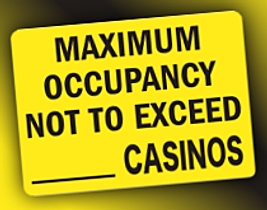 A week or so back, the Ohio Casino Control Commission said casino revenues fell by $3m in January. When Ohio authorized casino legislation in 2009, projections were that the state would reap $1.9b in annual taxes. The latest budget from Gov. John Kasich has revised that figure down to $1b. Penn National Gaming spokesman Bob Tenenbaum says around half of the shortfall can be blamed on the subsequent decision to also authorize video lottery terminals at seven Ohio racetracks.
A week or so back, the Ohio Casino Control Commission said casino revenues fell by $3m in January. When Ohio authorized casino legislation in 2009, projections were that the state would reap $1.9b in annual taxes. The latest budget from Gov. John Kasich has revised that figure down to $1b. Penn National Gaming spokesman Bob Tenenbaum says around half of the shortfall can be blamed on the subsequent decision to also authorize video lottery terminals at seven Ohio racetracks.
Earlier this month, Fitch gaming analyst Alex Bumazhny told Bloomberg the US land-based gaming market was “close to the saturation point. It’s almost a zero-sum game whenever a new casino opens.” University of Nevada, Reno professor Mark Nichols said casinos lose their ability “to out-entice somebody because everybody is pretty much the same and everybody is on the same playing field. Then it just comes down to location.”
Atlantic City has seen its annual gaming revenues cut in half since Pennsylvania opened its first casinos in 2006. Meanwhile, Pennsylvania table games revenue rose 12% in January, but it was a case of the rich (Sands Bethlehem, Parx) getting richer, while the state’s older casinos saw table revenues fall. In Illinois, business at the state’s newest joint, the Des Plaines Rivers Casino, was up 6.8% in January, but overall casino revenue fell 3%. In Maryland, casino revenue fell 2% in January, but over three-quarters of the total take went to Cordish Cos.’ new Maryland Live!. Maryland’s other two casinos – Ocean Downs and Penn National’s Hollywood Casino – saw revenue fall 6.5% and 44% respectively.
The appeal of the new and shiny has also been observed in Macau, where recently opened operations on the Cotai Strip are expected to post double-digit revenue gains this year, while their older rivals on the peninsula settle for single-digits. Some observers have predicted Macau as a whole will eventually suffer from new regional competition in the Philippines, Taiwan, South Korea, Vietnam and maybe even Hainan.
Obviously, anything is possible. As Las Vegas Sands’ chairman Sheldon Adelson noted last year, this is “a supply and demand industry.” But Macau’s operators are cutting slices out of a vastly larger pie. Adelson believes Las Vegas is visited by around 13% of the US population, while Macau garnered about 30m visits from Chinese residents last year. If Macau was visited by 13% of China’s population, “it would be close to 200 million visitations.” Like the man said, it all comes down to location.
